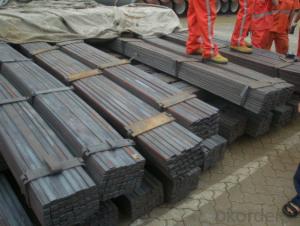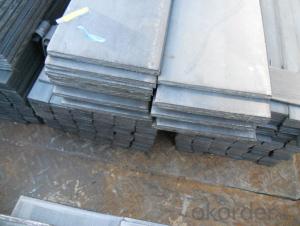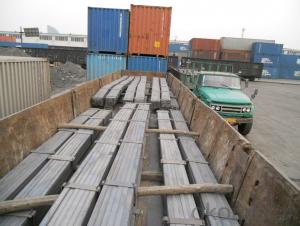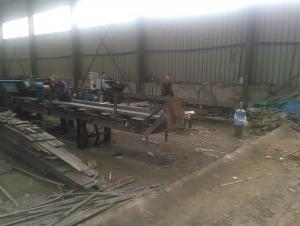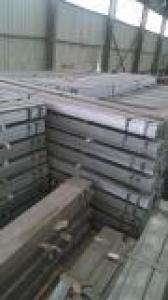Slit Cutting Flat Bar with Material Grade Q235
- Loading Port:
- Tianjin
- Payment Terms:
- TT OR LC
- Min Order Qty:
- 25 m.t
- Supply Capability:
- 10000 m.t/month
OKorder Service Pledge
OKorder Financial Service
You Might Also Like
OKorder is offering high quality Slit Cutting Flat Bar at great prices with worldwide shipping. Our supplier is a world-class manufacturer of steel, with our products utilized the world over. OKorder annually supplies products to European, North American and Asian markets. We provide quotations within 24 hours of receiving an inquiry and guarantee competitive prices.
Product Applications:
Slit Cutting Flat Bars are ideal for structural applications and are widely used in the construction of buildings and bridges, and the manufacturing, petrochemical, and transportation industries.
Product Advantages:
OKorder's Slit Cutting Flats Barare durable, strong, and resist corrosion.
Main Product Features:
· Premium quality
· Prompt delivery & seaworthy packing (30 days after receiving deposit)
· Corrosion resistance
· Can be recycled and reused
· Mill test certification
· Professional Service
· Competitive pricing
Product Specifications:
Manufacture: Slit Cutting
Grade: Q195 – 235
Certificates: ISO, SGS, BV, CIQ
Length: 6m – 12m, as per customer request
Packaging: Export packing, nude packing, bundled
Chemical composition of Q235
Alloy No | Grade | Element(%) | ||||
C
| Mn
| S
| P
| Si
| ||
Q235
|
B
|
0.12—0.20 |
0.3—0.7 |
≤0.045 |
≤0.045
|
≤0.3
|
Physical properties of Q235
Alloy No | Grade | Yielding strength point(Mpa) | Tensile strength (Mpa) | Elongation after fracture(%) | ||||||
Thickness (mm) | Thickness (mm) | |||||||||
≤16 | >16--40 | >40--60 | >60--100 | ≤16 | >16--40 | >40--60 | >60--100 | |||
≥ | ≥ | |||||||||
Q235 |
B |
235 |
225 |
215 |
205 |
375--500 |
26 |
25 |
24 |
23 |
FAQ:
Q1: Why buy Materials & Equipment from OKorder.com?
A1: All products offered byOKorder.com are carefully selected from China's most reliable manufacturing enterprises. Through its ISO certifications, OKorder.com adheres to the highest standards and a commitment to supply chain safety and customer satisfaction.
Q2: How do we guarantee the quality of our products?
A2: We have established an advanced quality management system which conducts strict quality tests at every step, from raw materials to the final product. At the same time, we provide extensive follow-up service assurances as required.
Q3: How soon can we receive the product after purchase?
A3: Within three days of placing an order, we will begin production. The specific shipping date is dependent upon international and government factors, but is typically 7 to 10 workdays.
Images:


- Q: How do steel flat bars contribute to the overall safety of a structure?
- Steel flat bars contribute to the overall safety of a structure in several ways. Firstly, they provide structural stability and support by effectively distributing and transferring loads, ensuring the integrity of the structure. Steel flat bars are strong and durable, with high tensile strength, which allows them to withstand heavy loads and forces without deformation or failure. Additionally, steel flat bars offer resistance against various environmental factors that can compromise the safety of a structure. Steel is highly resistant to fire, corrosion, and extreme weather conditions, making it a reliable choice for enhancing the longevity and safety of a building. Moreover, steel flat bars are often used in the construction of safety barriers, handrails, and guardrails. These elements are crucial for preventing accidents and falls, particularly in elevated areas or walkways. Steel flat bars provide a sturdy and secure barrier, ensuring the safety of individuals within the structure. Furthermore, steel flat bars are often utilized in seismic-resistant designs. Due to their high strength and flexibility, they can absorb and dissipate the energy generated during an earthquake or other seismic events. This feature greatly enhances the overall safety of a structure by minimizing the risk of collapse or structural damage during such incidents. In conclusion, steel flat bars play a vital role in ensuring the overall safety of a structure. Their strength, durability, resistance to environmental factors, and ability to provide structural stability make them an essential component in the construction industry. Whether it is in supporting loads, constructing safety barriers, or enhancing seismic resistance, steel flat bars contribute significantly to the safety and longevity of structures.
- Q: Can steel flat bars be used for staircase construction?
- Yes, steel flat bars can be used for staircase construction. They are commonly used as stringers or supports for the steps, providing strength and durability to the staircase structure.
- Q: How many years can hot dip galvanized flat steel be used?
- Coastal areas usually refer to a region within a mile of the sea. The ocean atmosphere can spread deeper inland, especially on islands. The prevailing winds come from the ocean, and the climate is bad. If the wind is mixed with ocean fog, especially due to evaporation and accumulation of salt deposits, coupled with less rain and less frequent rain erosion, coastal conditions will be even more unfavourable. If there is any industrial pollution, there is more corrosive. Hot galvanized flat steel in such circumstances, usually 20 years or so.
- Q: Is there a requirement for the ground resistance of the field motor? Is it good to use ground flat steel or ground wire?
- The enclosure is grounded and the ground wire is the same, and the ground wire requirement is no more than 4 ohms. Generally, the motor shell can be connected to zero. There is no need to ground. In the power system, earthing and zeroing can not be mixed.
- Q: What is the difference between a steel flat bar and a steel hex bar?
- The main difference between a steel flat bar and a steel hex bar lies in their shape and design. A steel flat bar, as the name suggests, is a long, rectangular-shaped bar with a flat surface on all sides. It has a uniform thickness throughout its length and is typically used for structural applications, such as supports, braces, and framing. The flat surface allows for easy fastening or welding to other components. On the other hand, a steel hex bar is a bar with six equal sides, forming a hexagonal shape. This unique design provides increased strength and stability compared to a flat bar. The hexagonal shape also offers better grip and torque resistance, making it suitable for applications that require high tensile strength, such as machinery, tools, and hardware components. In terms of versatility, a steel flat bar can be easily manipulated, cut, or bent to fit various shapes and sizes, making it a more flexible option for different projects. Conversely, a steel hex bar is more rigid and less malleable due to its six-sided structure, limiting its adaptability but enhancing its strength. In summary, while both steel flat bars and steel hex bars are made from the same material, their distinct shapes and designs make them suitable for different applications. The flat bar is commonly used for structural purposes, while the hex bar is preferred for applications requiring higher strength and torque resistance.
- Q: How do you protect steel flat bars from chemical exposure?
- To protect steel flat bars from chemical exposure, there are several measures you can take. 1. Coating: Applying a protective coating is one of the most effective ways to shield steel flat bars from chemical exposure. There are various types of coatings available, such as epoxy, polyurethane, or zinc-based coatings, that can provide a barrier between the steel and the chemicals. These coatings should be carefully selected based on the specific chemicals the steel will be exposed to and their compatibility with the coating material. 2. Galvanization: Galvanizing the steel flat bars can offer excellent protection against chemical exposure. This process involves coating the steel with a layer of zinc, which acts as a sacrificial barrier. When the steel comes into contact with chemicals, the zinc coating corrodes instead of the steel, preventing direct chemical attack. 3. Stainless steel: Using stainless steel flat bars, particularly those made from corrosion-resistant grades such as 316 or 304, can provide excellent resistance to chemical exposure. Stainless steel contains a minimum of 10.5% chromium, which forms a protective oxide layer on its surface, preventing corrosion by most chemicals. 4. Proper storage: Storing steel flat bars in a controlled environment can help minimize chemical exposure. Ideally, the storage area should be dry, well-ventilated, and free from any direct contact with corrosive substances. Additionally, proper stacking and separation of different materials can prevent chemical reactions and potential damage. 5. Regular maintenance: Regular inspection and maintenance are essential to ensure the continued protection of steel flat bars from chemical exposure. Any signs of coating damage or corrosion should be addressed promptly. Cleaning the surface using appropriate methods and products can help remove any chemical residues and maintain the integrity of the protective measures. It is important to note that the specific protective measures will depend on the type and concentration of chemicals the steel flat bars will be exposed to. Therefore, consulting with corrosion and material experts or referring to industry standards and guidelines can provide more tailored recommendations for protecting steel flat bars in a specific chemical environment.
- Q: Can steel flat bars be used for making tools or machinery?
- Yes, steel flat bars can be used for making tools or machinery. Steel is a widely used material in tool and machinery manufacturing due to its high strength, durability, and versatility. Steel flat bars can be easily shaped, cut, or welded to create various tools and machine parts, making them a suitable choice for such applications.
- Q: How do steel flat bars contribute to the durability of structures?
- The durability of structures is enhanced by steel flat bars in several ways. First and foremost, steel possesses extraordinary strength and resilience. It boasts a high tensile strength, enabling it to withstand substantial force or pressure without deformation or breakage. This strength is crucial for structures that must bear heavy loads or endure harsh environmental conditions. Furthermore, steel flat bars exhibit exceptional corrosion resistance. To further fortify its resistance to corrosion, steel is often coated with protective materials such as zinc or paint. This is particularly vital for structures exposed to moisture, chemicals, or other corrosive elements. By thwarting rust and corrosion, steel flat bars promote the durability and structural integrity of buildings and infrastructure. Moreover, steel flat bars are versatile and can be easily manipulated and shaped to satisfy specific design requirements. They can be welded, bent, cut, or drilled to accommodate diverse architectural or engineering needs. This adaptability permits the creation of intricate and innovative structures. Additionally, steel flat bars possess superior fire resistance. Unlike other materials, steel does not burn or contribute to the propagation of fire. This renders it an ideal choice for structures where fire safety is a concern. Lastly, steel flat bars are highly sustainable and environmentally friendly. Steel is one of the most recycled materials worldwide, and its recycling process demands substantially less energy compared to the production of new steel. By incorporating steel flat bars in construction, we can reduce the carbon footprint and contribute to a more sustainable future. To conclude, the durability of structures is enhanced by steel flat bars due to their provision of strength, corrosion resistance, versatility, fire resistance, and sustainability. These properties make them an optimal choice for a wide array of construction projects, ensuring the longevity and safety of the built environment.
- Q: What is the minimum order quantity for steel flat bars?
- The minimum order quantity for steel flat bars may vary depending on the supplier or manufacturer. It is recommended to contact the specific supplier or manufacturer to inquire about their minimum order quantity for steel flat bars.
- Q: Are steel flat bars suitable for welding projects?
- Indeed, welding projects find steel flat bars to be a fitting choice. Owing to their adaptability and robustness, steel flat bars are frequently employed in welding endeavors. Their level surface facilitates ease of manipulation and welding, thereby enabling accurate and sturdy connections. With a range of sizes and thicknesses on offer, steel flat bars cater to diverse types of welding projects. Moreover, steel's renowned durability and heat resistance greatly contribute to welding. All in all, steel flat bars prove to be a dependable and widely utilized material in welding projects.
Send your message to us
Slit Cutting Flat Bar with Material Grade Q235
- Loading Port:
- Tianjin
- Payment Terms:
- TT OR LC
- Min Order Qty:
- 25 m.t
- Supply Capability:
- 10000 m.t/month
OKorder Service Pledge
OKorder Financial Service
Similar products
Hot products
Hot Searches
Related keywords
